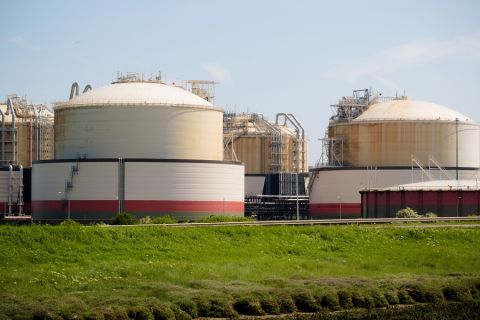
The swings in commodity prices can easily undermine the earnings and efforts of oil producers, but BofA Merrill Lynch’s Doug Leggate says he remains a fan of several E&Ps including Anadarko Petroleum and Devon Energy. (Source: Hart Energy/Shutterstock.com)
E&P companies reported mixed results for the fourth quarter as Anadarko Petroleum Corp.’s (NYSE: APC) earnings missed Wall Street estimates while Occidental Petroleum Corp. (NYSE: OXY) reported a profit but estimated lower revenue for its midstream unit.
Anadarko Petroleum is viewed favorably by BofA Merrill Lynch’s Doug Leggate, who is bullish on the energy sector even though crude oil prices have remained in the $50 a barrel range. He says Anadarko has a price objective of $80.
The swings in commodity prices can easily undermine the earnings and efforts of oil producers, Leggate said but noted he remains a fan of Devon Energy Corp. (NYSE: DVN) with a $47 price objective, Concho Resources Inc. (NYSE: CXO) with a $155 price target and Hess Corp. (NYSE: HES).
Anadarko, the Woodlands, Texas-based producer, has U.S. onshore assets are focused in the Denver-Julesburg (D-J) Basin and the Delaware Basin within the Permian, which both delivered record production in the fourth quarter with average oil sales volume increasing 6% and 7% from the prior quarter, respectively.
The company also operates offshore in the U.S. Gulf of Mexico as well as internationally in Algeria, offshore Ghana and Mozambique.
Anadarko reported earnings of $102 million or 21 cents a share in the fourth quarter compared with $976 million or $1.80 a share compared to the previous year. The company’s revenue rose to $3.3 billion from $2.9 billion a year ago.
Meanwhile, Houston-based Occidental Petroleum, commonly referred to as Oxy, reported its fourth-quarter profits rose by 42% to $706 million from $497 million in the same quarter in 2017 and beat expectations when it earned $1.22 per diluted share earnings or 8 cents higher than analysts' estimates. However, the feedback from Wall Street on Oxy was negative.
Leggate said Oxy’s fourth quarter was “messy,” but conceded the company’s overall performance was solid and reiterated a buy rating with an unchanged $85 price target. UBS analyst Lloyd Byrne maintains a neutral rating with a $71 price target
Paul Y. Cheng, an equity analyst for Barclays Capital, downgraded Oxy to underweight from overweight after the producer reported its earnings results and lowered the target to $70 from $77.
Oxy could face some issues and could “struggle to ramp capex back up to $5 billion to $5.3 billion as planned unless prices move higher,” he wrote in a research report
“In light of the narrower Midland discount, lower caustic soda prices and resulting reduction in company guidance, we have sharply cut our non-E&P cash flow forecasts,” Cheng wrote. “Assuming $60 Brent and $49 WTI in 2019, we estimate Oxy will deliver full-year free cash flow of $1.2 [billion to] $1.3 billion before the dividend. We forecast this will improve to roughly $2.1 billion in 2020 at $65 Brent and $58 WTI.”
Cheng also cited Oxy’s Permian Basin growth target as being “somewhat aggressive.”
Oxy is one of the largest operators and oil producers in the Permian Basin with nearly 2.5 million net acres in the prolific basin across New Mexico and West Texas, according to the company’s website. The company also has upstream operations in the Middle East and Latin America.
Declining oil prices and other issues which emerged during earnings season sank the stock of many other E&P companies by as much as 50%. Here’s a summary on the fourth-quarter results for other U.S. shale producers, including the following: Antero Resources Corp. (NYSE: AR), Laredo Petroleum Inc. (NYSE: LPI), Marathon Oil Corp. (NYSE: MRO), EQT Corp. (NYSE: EQT), Pioneer Natural Resources Co. (NYSE: PXD) and Continental Resources Inc. (NYSE: CLR).
- Denver-based Antero Resources has faced a difficult year as its stock fell from its 52-week high of $22.69 to a 52-week low of $8.52. The company reported revenue in the fourth quarter was $1 billion, nearly equivalent to the prior year period with a net loss of $122 million, or $0.39 per share, compared to net income of $487 million or $1.54 per diluted share, in the prior year period. Antero is a pure-play Appalachia operator with over 612,000 net acres in the southwestern core of the Marcellus and Utica shales and 18 trillion cubic feet equivalent of net proved reserves, according to the company’s website.
- Laredo Petroleum, a Tulsa, Okla.-based producer, has also reported a difficult year when its stock fell from a 52-week high of $11.18 to a 52-week low of $3. The company said it is addressing the reduced oil productivity issues in 2018 “that we believe was impacted by the tighter spacing of some wells drilled in 2017 and 2018.” For the fourth quarter, the company reported net income of $149.6 million or $0.65 per diluted share and adjusted EBITDA was $132.4 million. Laredo’s operations are currently focused in the Permian Basin. The company has over 140,000 gross acres, 85% HBP, centered on the east side of the basin primarily in Glasscock and Reagan counties, Texas.
- Houston-based Marathon Oil reported net income of $390 million or 47 cents per share, compared to a loss of $28 million or 3 cents per share, a year earlier. Marathon beat analysts’ estimates due to the higher production of its U.S. shale assets, where the company plans to invest more than 95% of its 2019 development capital. The company’s portfolio currently focuses on the Bakken, Permian, Stack/Scoop and Eagle Ford shale plays.
- Pittsburgh-based oil and gas producer EQT reported revenue of $394 million with a net loss of $598 million. In 2018, the company completed it noncore Huron and Permian Basin asset divestitures for net proceeds of $580 million which also relieved EQT of $240 million in liabilities. The company has also agreed to pay $54 million to West Virginia landowners who sued the company over royalty payments between 2009 and 2017. EQT is the largest natural gas producer in the U.S., producing more than 4 billion cubic feet equivalent per day, according to a company presentation from January. The company currently holds 680,000 net acres in the core of the Marcellus Shale with a 15- to 20-year drilling inventory. (RELATED: Rice Brothers Vie For Control Of EQT)
- Irving-based Pioneer Natural Resources missed analysts' earnings by a wide margin. The company reported a profit of $202 million or $1.18 per share. Analysts had anticipated a profit of $1.54 per share. The company’s stock has taken a beating this year as its 52-week high of $213.40 plummeted to a 52-week low of $119.08. Pioneer Natural Resources also said that CEO Timothy Dove would retire and has been replaced by Scott Sheffield, the company’s chairman and founding CEO. Over the past year, the company streamlined its portfolio, divesting $865 million of noncore assets to reposition itself as a pure-play Permian operator. The company currently holds a 680,000 net-acre position in the basin with a resource base of over 10 billion barrels of oil equivalent.
- The stock of Continental Resources, an Oklahoma City-based company, has fallen during the past year from its 52-week high of $71.95 but has rebounded from its 52-week low of $35.54. Continental Resources missed analysts’ earnings estimate of $0.61 per share and produced $0.54 per share because its net income rose 31.7% along with its adjusted operating income by 1.5% to $850.6 million. Additionally, CEO and chairman Harold Hamm bought more shares in the company, according to a Securities and Exchange Commission filing, paying $39.3 million for 883,977 Continental shares on Feb. 21 and 22. Hamm owns a total of 2,626,199 Continental shares in his personal account, including unvested restricted stock, plus another 283.1 million shares through a limited liability company. Continental’s three core assets include positions in the Bakken in North Dakota and Montana as well as the Stack and Scoop plays in Oklahoma.
Recommended Reading
Shipping Traffic Freezes Up in Port Waters After Baltimore Bridge Collapse
2024-03-26 - U.S. port of Baltimore traffic was suspended until further notice following a bridge collapse. At least 13 vessels expected to load coal were anchored near the port at the time of the incident.
What's Affecting Oil Prices This Week? (April 22, 2024)
2024-04-22 - Stratas Advisors predict that despite geopolitical tensions, the oil supply will not be disrupted, even with the U.S. House of Representatives inserting sanctions on Iran’s oil exports.
What's Affecting Oil Prices This Week? (April 15, 2024)
2024-04-15 - While concerns about the stability of oil supply are increasing, Stratas Advisors does not expect oil supply to be disrupted – unless there is further escalation in the Middle East.
Venture Global, Grain LNG Ink Deal to Provide LNG to UK
2024-02-05 - Under the agreement, Venture Global will have the ability to access 3 million tonnes per annum of LNG storage and regasification capacity at the Isle of Grain LNG terminal.
WoodMac: Market Likely to Absorb Aramco’s Downshift in Oil Production
2024-02-02 - Saudi Aramco’s move from a targeted 13 MMbbl/d capacity by 2027 is not expected to tighten the supply and demand balance this decade, Wood Mackenzie analysts said.




